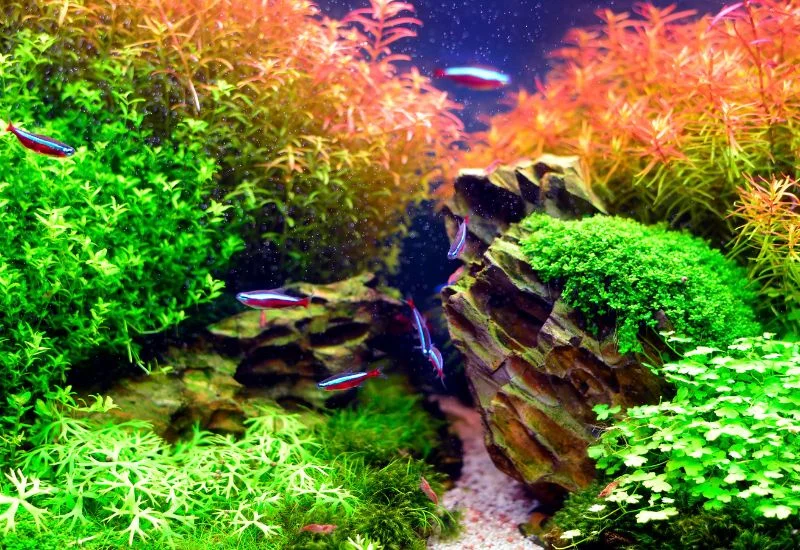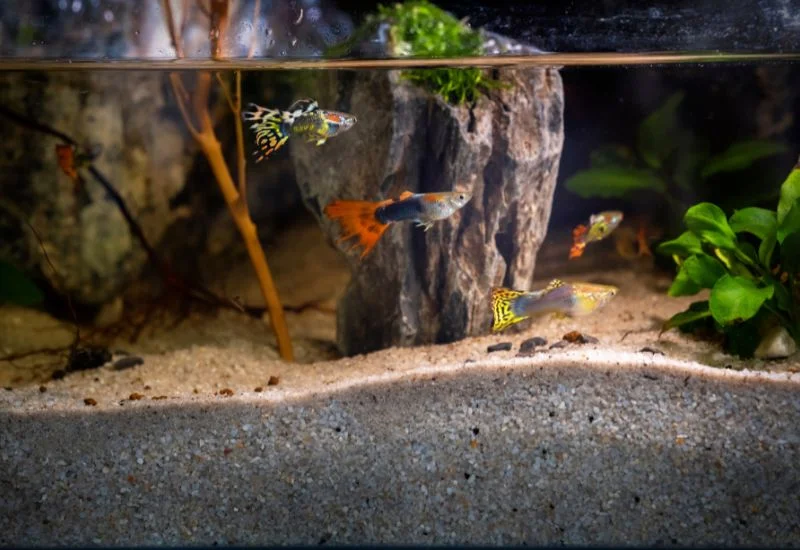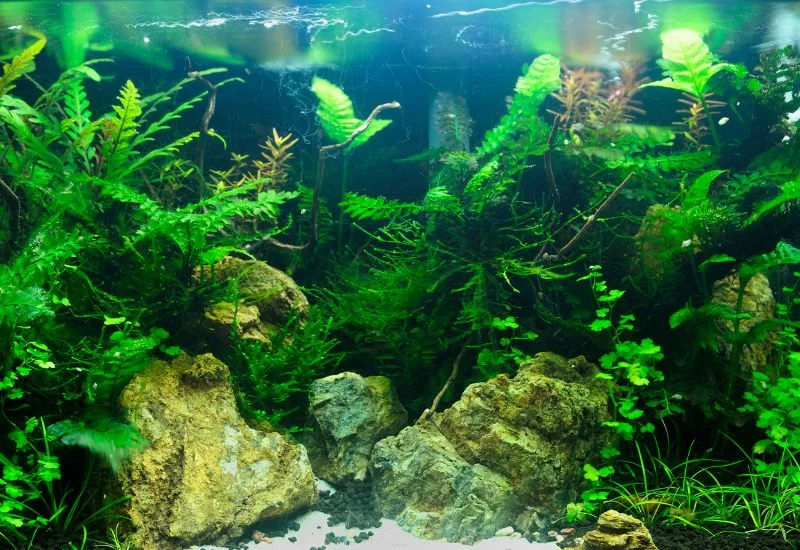Designing aquascapes can be challenging, as it involves creating underwater landscapes inspired by natural scenes such as mountains, trees, jungles, and lakes.
Designing an aquascape can be challenging. There are so many endless possibilities of designs that one can make depending on one’s creativity.
You can seek inspiration from other designs to have an idea of what kind of design you want to have. You can make a sketch first before physical implementation.
What is Aquascaping?
Aquascaping is defined as underwater gardening. The layout of the tank is made with the help of stones, plants and driftwood. For aquascaping there are three main underwater layouts: the Nature aquarium, Dutch style and Japanese style.
Foundations of Advanced Aquascaping

Aquascaping is an art to build nature in tiny tanks. It’s not very difficult nowadays; you can easily grow plants and visualize the design. Here is a step to step guide for foundation.
Tank
For aquascaping the first thing you need is the tank. For the start the small tank will be a good option as it takes less space. The size of the tank matters a lot. If the tank is small, environmental changes are more likely to occur. Conversely, a large tank has a lower impact on the environment if water conditions change.
The small tank works fine but needs extra care. In summer, you have to add a fan to cool down the water temperature. You can also add a specific amount of water into the tank to deal with evaporation.
Water Filter
For the good quality of water and health of fish, a water filter is an essential tool. Water filters are installed into the aquarium. In the filter, bacteria live and help maintain water balance. The bacteria cleans the water by fighting chemicals like Ammonia. Nitrate, Nitrite.
The filter can be installed outside the tank, under the table, or on the wall. That filter is used for big tanks. There are three common methods to filter the water. Biological, Chemical and Mechanical.
The light
Every aquarium needs proper light for the growth of plants in the water. You can use LED lights. The lights can be installed or can be hung over the aquarium. For the growth of plants, the timer needs to be set to create a cycle of day and night.
More exposure of light on the plants can contribute to the growth of algae and can also damage the color and health of the plants. The duration of light can be determined on the type of plants and fishes we have.
CO2
CO2 is very important for the growth of plants even if you have few in the aquarium. It helps plants to maintain their color and to breathe. CO2 is always available in the water which comes from the surroundings. The additional CO2 can be provided by the diffusers.
In the aquarium the bottles of CO2 are installed underwater. CO2 is released by the diffusers in the shape of bubbles so it can be absorbed by water. The bottle of CO2 can be installed in every aquarium even in nano aquariums. The bottles need to be changed for fill up according to their size.
The water
The most important aspect of aquascaping is water. You can use tap water but check the quality. In the tap water there can be harmful chemicals like chlorine and phosphate. The quality can be checked through kits available in the market. Before releasing the fish into the tank, check the water temperature to provide the best environment.
Advanced Planting Techniques
Here are three commonly used techniques.
The Nature Aquarium
The nature aquarium is the most commonly used aquarium style. The main reflection of this style is to mimic nature. The nature style was first introduced in the 90s by a Japanese aquarist, Takashi Amano. The nature aquarium is mostly formed using aquatic plants, rocks, and driftwood. For the making of the aquarium, inspiration mostly comes from nature itself, such as jungles, mountains, lakes, and beaches. To provide a real visual of nature, a Japanese gardening technique of the golden ratio is used.
Shapes for Nature Aquarium
There are different layouts to use while making the aquarium:
- The first layout is called concave shape, where the plants are removed from the central low point. It gives a wide space look.
- The next layout is convex. This style represents the shape of an island. The plants are trimmed from both sides to give a mountain look. The mountain can be made with the help of stones.
- The next is the triangle shape. The layout style is just like its name. The plants are high on the edge and make a slop.
Iwagumi – Japanese Aquascaping Style

This is a very simple technique. From the start, use one or two slow-growing plants, which will give a simple look. This style was first also used by Japanese aquarist Amano. This style represents the culture of the Japanese. The stones that were used in the first Iwagumi aquarium were Senmigawa stones.
The layout was planted with only Echinodorus tenellus. Later, Cardinal Tetras were introduced as well. In this layout, the three stones are used. One headstone plays the lead role, and two others on the sides. The layout is not just about placing the stones; it’s about achieving that harmony.
The Different Features of Iwagumi
The stone in this style is used on odd numbers. There is no restriction on using a specific stone. Seiryu, Manten, and Ohko Dragon stones are mostly used. In this style, each stone has a specific style:
- Oyaishi is a main and beautiful stone. It uses the ratio of thirds to capture the perfect human eye’s attention according to the golden ratio theory.
- The second stone is Fukuishi. This is the second largest stone and is placed on the left or right side of the Oyaishi. The main purpose of this stone is to create balance in the primary stone.
- The next stone is Soeishi, which is placed with Oyaishi. This provides the balance to the first stone.
- The last stone lace in the Iwagumi layout is Suteishi. This is the biggest stone, but this stone is normally covered with plants. The main purpose of this stone is to provide a complete look to the layout.
Dutch Aquarium

This style firstly came to notice in the 1930’s in the Netherlands. This style doesn’t use any driftwood or rocks or any solid materials. The main material is plants to give a natural underwater garde look. The dutch style aquarium does not resemble a specific place of nature. Plants in the water are different in size and color to provide each other a complete look.
Layout Techniques
- The first layout technique is called Terracing. This layout focused on focal points by using the rule of third. The focal points are highlighted by red or large plants.
- To provide the perfect look of a dutch aquarium add plants 70% of the plants on the aquariums floor.
- Next technique is contrast. The density of plants is separated on the basis of contrast. Make sure there is contrast on the basis of plant color and size of leaf.
Water Quality Management
The water quality can be checked by testing, the pH level of water, the amount of nitrate and narrates can be checked. To maintain the quality the water of the aquarium should be changed on regular needs.
Also, check the temperature of the water to provide the best environment. Plants should be planted as they provide a natural look, help fight algae, and keep the water clean.
Troubleshooting Common Aquascaping Issues

Here are some problems that aquarists should avoid:
- Make sure to change the water on time. The avoidance leads to the algae growth in the water.
- Place many plants in an aquarium. It will provide a clean environment and contribute to the maintenance of water quality.
- Don’t overstock your tank, it will put your fish into stress. It also contributes to the making of toxic chemicals in the water.
- For the growth of plants fertilizers are used. Do not overuse the fertilizer; it will affect the health of the plant.
Conclusion
Aquascaping is the art of mimicking nature. There are no boundaries of style. There are endless innovations. Different methods are used to form the layout for aquascaping. There are three most common methods: The nature Aquarium, Iwagumi Japanese style and Dutch style.
While formatting the layout these methods are used for consideration. The other factors like water, tank planets play a vital role to provide a healthy environment. Once the aquarium is ready, keep it in monitoring to manage the quality of the aquarium.
